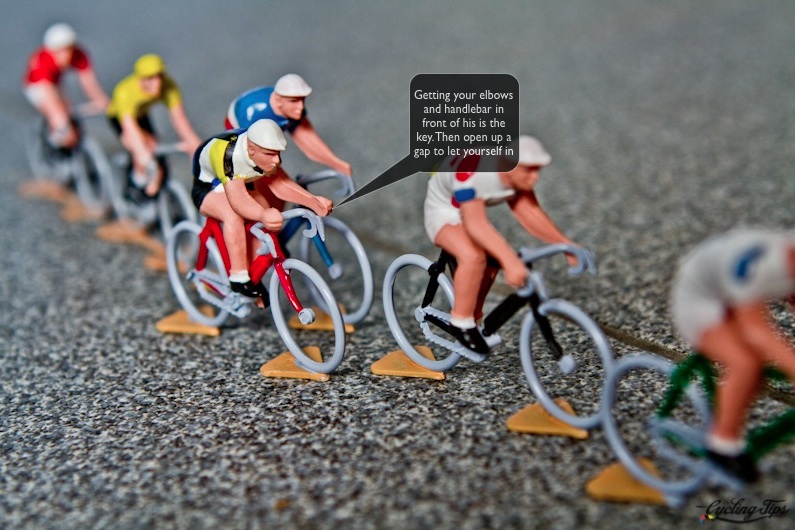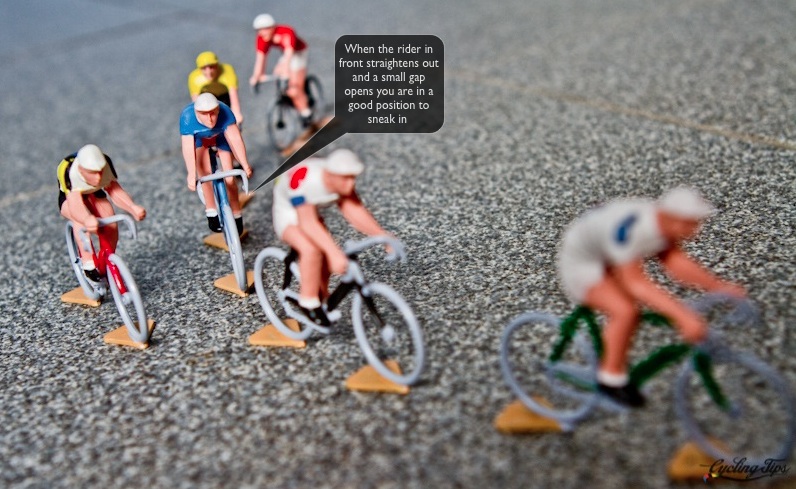Stealing A Wheel
1. The easiest and most effective way to take someone’s wheel is by simply asking. Ride up next to him, point that you’re coming in, and he’ll most likely open up a gap for you to fill. Give him a little wave as a thank you gesture. During the final kilometer of a race this won’t work, but 99% of the time someone will let you in and there’s no need for agressive maneuvers. If someone won’t let you in, then look for someone else close by who will.

2. Another easy way of moving up in the pack is to simply look for weaker riders who are dropping wheels. Ride up and fill in the gap. It’s that easy. There’s no sense in trying to negotiate the wheel off someone strong when there’s a much easier option near by.
By the same token, you really don’t want to be behind a rider who is consistently dropping wheels anyway. You’ll forever be closing their gaps and wasting valuable energy. Sometimes dropping the wheel and creating gaps is intentional, but you’ll be able to tell by the body language of the offending rider.

3. The widest part of your bike is the handlebars. As long as your handlebars are in front of someone else’s, you can create a gap and inch yourself into the line. This is the most common way of squeezing yourself onto someone’s wheel when the pace is on (and there’s no time to politely ask). This is a more assertive method of stealing a wheel. Just be careful of not moving into the gap too quickly chopping the guy behind you. If you’re not familiar with what “chopping” means, this is probably too advanced of a move for you at this point.

4. Use the corners. Many riders drop wheels in the corners. If it’s a very fast swooping turn in the course and you position yourself on the outside you’ll often find a gap that you can jump into. If there’s no gap that opens up and you hold your line you’ll often find that a rider you’re trying to get in front has no choice but to let you in. The same goes when the bunch is stretched out and it’s snaking from side to side on the road. You can sometimes take advantage of that motion of the peloton to nudge your way into a better position.
Remember, never ever come around a corner on the inside to try and make up positions. As the saying goes: “Inside Suicide”. Not only is it dangerous, but your popularity in the bunch will diminish very quickly if you continue doing this.

5. During the final kilometers of a race the spriters will start moving to the front. Everyone knows whose wheel to be on and it’s a dogfight for it. Asking politely certainly isn’t going to work and a bunch of psychotic sprinters aren’t letting anyone take their wheel. They’ll be bumping shoulders and elbows jostling for position. You need to be extremely skilled and have balls the size of Texas to mix it up with those guys. I won’t go into the tricks of the trade at the pointy end of sprint finish. It’ll get someone killed. Just remember, often the sprint isn’t to the finish line, the sprint is to the final corner.
Gaining Position
1. There’s no sense in trying to move up in the bunch when the pace is at 50km/hr. Everyone is chewing their handlebar tape and are glued to the wheel in front. It’ll take a lot of energy for you to move up in position and you’ll need to be agressive to steal someone’s wheel. Wait until there’s a lull in the pace to move up. If the time is right, this is often the best time to attack as well.
2. Positioning yourself in the middle of the bunch is sometimes the worst place to be. You need to be able to catch on to the swarms of riders who fly past you in order to gain positions. It’s much easier latching onto the swarms while they’re moving up the side of the bunch than exposing yourself to the wind and doing it yourself. I prefer to position myself on the side of the peloton that’s sheltered from the wind.
3. If you’re moving up through pack and you need a rider to move over, simply put the back of your hand on the hip of the rider you want to move over. Most of the time he’ll know what that means and move over so you can get through.
Reading about these positioning skills will only give you an small appreciation of the intricacies of riding in a pack. None of these things should be attempted without practise and experience. Some of these moves can be dangerous if you don’t know the exact circumstances they should be used in. I probably don’t need to say that, but I don’t want to be the blame for a massive stack this weekend!

Pingback: Fiona Moore
Pingback: Kids sleeping bags